Assessment of the Possibility of Using Fly Ash from Biomass Combustion for Concrete
Abstract
:1. Introduction
2. Materials and Methods
2.1. Materials
2.2. Methods
3. Results
3.1. Properties of Concrete Mixes
3.2. The Impact of Ash Addition on the Compressive Strength of Concrete
3.3. The Impact of Ash Addition on the Water Absorption of Concrete
3.4. The Impact of Ash Addition on Concrete Low-Temperature Resistance
3.5. Water Penetration of Concretes Containing Ash from Biomass Combustion
3.6. Leaching Metal Ions from Concretes Containing Ash from Biomass Combustion
3.7. Microstructure of Composites with a Cement Matrix Containing Ashes from Biomass Combustion
4. Conclusions
- The conducted tests of the properties and structure of composite materials with a cement matrix containing waste fluidized ashes from the combustion of wood–sunflower biomass (in the proportion of 80% wood waste and 20% sunflower waste) and the analysis of the obtained results enabled the conclusion that this ash, in the amount of 10% and up to 30%, can be added as a sand replacement for the production of composite materials with a cement matrix, such as concretes (made on the basis of CEM I or CEM II/A-V 42.5R cement), without reducing their quality (compression strength and low-temperature resistance) in relation to materials produced without the addition of waste ash.
- The microstructure of concretes made on the basis of CEM I 42.5R cement containing fly ash from biomass combustion in the amount of 10–30% is marked by a microstructure very similar to the control concrete made without the addition of waste ash.
- The addition of fly ash in the amount of 10–30% causes the concrete mix to condense and reduce its air content. The compression strength of concrete samples with sand–gravel and sand–basalt mixtures of aggregates made with the tested additive is higher than that obtained for the control samples.
- The use of fly ash in the range of 10–30% causes a slight increase in the water absorption of concrete samples made with both sand–gravel and sand–basalt mixes of aggregates. The addition of waste ashes increases the depth of water penetration of the samples of all tested concrete series.
- The addition of fly ash from biomass to concretes in amounts up to 30% reduces the decrease in compression strength of these concretes after low-temperature resistance tests and does not cause the formation of fragments, cracks and defects in the sample. In addition, concrete composites containing the addition of ash from biomass combustion, taking into account the crack of the composite and the penetration of water, do not show a negative impact on the natural environment related to the leaching (release) of heavy metals into the environment.
- The use of waste ash has a positive effect on the natural environment by reducing the demand for natural resources. The use of fly ash in the amount of 30% of the cement mass as a sand substitute, depending on the type of aggregate mixture, reduces sand usage by 115–120 kg/m3, i.e., by about 15–20%.
Author Contributions
Funding
Institutional Review Board Statement
Informed Consent Statement
Data Availability Statement
Acknowledgments
Conflicts of Interest
References
- Sekar, T.; Ganesan, N.; Nampoothire, N. Studies on strength characterization on utilization of waste materials as coarse aggregate in concrete. Int. J. Eng. Sci. Technol. 2011, 3, 5436–5440. [Google Scholar]
- Argiz, C.; Menéndez, E.; Sanjuán, M.A. Effect of mixes made of coal bottom ash and fly ash on the mechanical strength and porosity of Portland cement. Mater. Constr. 2013, 63, 49–64. [Google Scholar]
- Baran, T.; Drożdż, W. Evaluation of properties of domestic calcareous fly ash and its processing methods. Roads Bridges Drog. Mosty 2013, 12, 5–15. [Google Scholar]
- Cheriaf, M.; Cavalcante, J.; Péra, J. Pozzolanic properties of pulverized coal combustion bottom ash. Cem. Concr. Res. 1999, 29, 1387–1391. [Google Scholar] [CrossRef]
- Dziuk, D.; Giergiczny, Z.; Garbacik, A. Calcareous fly ash as a main constituent of common cements. Roads Bridges Drog. Mosty 2013, 12, 57–69. [Google Scholar]
- Fan, W.J.; Wang, X.Y.; Park, K.B. Evaluation of the Chemical and Mechanical Properties of Hardening High-Calcium Fly Ash Blended Concrete. Materials 2015, 8, 5933–5952. [Google Scholar] [CrossRef] [PubMed] [Green Version]
- Gazdiča, D.; Fridrichováa, M.; Kulíseka, K.; Vehovská, L. The potential use of the FBC ash for the preparation of blended cements. Procedia Eng. 2017, 180, 1298–1305. [Google Scholar] [CrossRef]
- Kocak, Y.; Nas, S. The effect of using fly ash on the strength and hydration characteristics of blended cement. Constr. Build. Mater. 2014, 73, 25–32. [Google Scholar] [CrossRef]
- Strigáč, J.; Števulová, N.; Mikušinec, J.; Sobolev, K. The fungistatic properties and potential application of by-product fly ash from fluidized bed combustion. Constr. Build. Mater. 2018, 159, 351–360. [Google Scholar] [CrossRef]
- Yao, Z.T.; Ji, X.S.; Sarker, P.K.; Tang, J.H.; Ge, L.Q.; Xia, M.S.; Xi, Y.Q. A comprehensive review on the applications of coal fly ash. Earth Sci. Rev. 2015, 141, 105–121. [Google Scholar] [CrossRef] [Green Version]
- Anderson, D.J.; Smith, S.T.; Au, F.T.K. Mechanical properties of concrete utilising waste cerami cascoarse aggregate. Constr. Build. Mater. 2016, 117, 20–28. [Google Scholar] [CrossRef]
- Collivignarelli, M.C.; Cillari, G.; Ricciardi, P.; Miino, M.C.; Torretta, V.; Rada, E.C.; Abbà, A. The production of sustainable concrete with the use of alternative aggregates: A review. Sustainability 2020, 12, 7903. [Google Scholar] [CrossRef]
- Subramani, T.; Suresh, B. Experimental investigation of using ceramic waste as a coarse aggregate making a light weight concreto. Int. J. Appl. Innov. Eng. Manag. 2015, 4, 153–162. [Google Scholar]
- Halicka, A.; Ogrodnik, P.; Zegardlo, B. Using ceramic sanitary ware waste as concrete aggregate. Constr. Build. Mater. 2013, 48, 295–305. [Google Scholar] [CrossRef]
- Medina, C.; Frías, M.; Sánchez de Rojas, M.I. Microstructure and properties of recycled concretes using ceramic sanitary ware industry waste as coarse aggregate. Constr. Build. Mater. 2012, 31, 112–118. [Google Scholar] [CrossRef]
- Medina, C.; Frías, M.; Sánchez de Rojas, M.I.; Thomas, C.; Polanco, J.A. Gas permeability in concrete containing recycled ceramic sanitary ware aggregate. Constr. Build. Mater. 2012, 37, 597–605. [Google Scholar] [CrossRef]
- Ray, S.; Haque, M.; Soumic, S.A.; Mita, A.F.; Rahman, M.D.M.; Tanmoy, B.B. Use of ceramic wastes as aggregates in concrete production: A review. J. Build. Eng. 2021, 43, 102567. [Google Scholar] [CrossRef]
- Ulewicz, M.; Halbiniak, J. Application of waste from utilitarian ceramics for production of cement mortar and concrete. Physicochem. Probl. Miner. Process. 2016, 52, 1002–1010. [Google Scholar]
- Adhikary, S.K.; Ashish, D.K.; Rudžionis, Z. Expanded glass as light-weight aggregate in concrete—A review. J. Clean. Prod. 2021, 313, 127848. [Google Scholar] [CrossRef]
- Omoding, N.; Cunningham, L.S.; Lane-Serff, G.F. Effect of using recycled waste glass coarse aggregates on the hydrodynamic abrasion resistance of concrete. Constr. Build. Mater. 2021, 268, 121177. [Google Scholar] [CrossRef]
- Walczak, P.; Małolepszy, J.; Reben, M.; Rzepa, K. Mechanical properties of concrete mortar based on mixture of CRT glass cullet and fluidized fly ash. Procedia Eng. 2015, 108, 453–458. [Google Scholar] [CrossRef] [Green Version]
- Walczak, P.; Małolepszy, J.; Reben, M.; Szymański, P.; Rzepa, K. Utilization of Waste Glass in Autoclaved Aerated Concrete. Procedia Eng. 2015, 122, 302–309. [Google Scholar] [CrossRef] [Green Version]
- Kishore, K.; Gupta, N. Application of domestic & industrial waste materials in concrete: A review. Mater. Today Proc. 2020, 26, 2926–2931. [Google Scholar] [CrossRef]
- Pietrzak, A.; Ulewicz, M. The Effect of the Addition of Polypropylene Fibres on Improvement on Concrete Quality. MATEC Web Conf. 2018, 183, 02011. Available online: http://doi.org/10.1051/matecconf/201818302011 (accessed on 7 November 2021).
- Ulewicz, M.; Pietrzak, A. Properties and Structure of Concretes Doped with Production Waste of Thermoplastic Elastomers from the Production of Car Floor Mats. Materials 2021, 14, 872. [Google Scholar] [CrossRef]
- Johnson, A.; Catalan, L.J.J.; Kinradeb, S.D. Characterization and evaluation of fly-ash from co-combustion of lignite and wood pellets for use as cement admixture. Fuel 2010, 89, 3042–3050. [Google Scholar] [CrossRef]
- Saraber, A.J. Fly Ash from Coal and Biomass for Use in Concrete Origin, Properties and Performance. Ph.D. Thesis, Delft University of Technology, Delft, The Netherlands, 2017. [Google Scholar] [CrossRef]
- Tkaczewska, E.; Mróz, R.; Łój, R. Coal–biomass fly ashes for cement production of CEM II/A-V 42,5R. Constr. Build. Mater. 2012, 28, 633–639. [Google Scholar] [CrossRef]
- Tkaczewska, E.; Małolepszy, J. Hydration of coal–biomass fly ash cement. Constr. Build. Mater. 2009, 23, 2694–2700. [Google Scholar] [CrossRef]
- Wang, S.; Miller, A.; Llamazos, E.; Fonseca, F.; Baxter, L. Biomass fly ash in concrete: Mixture proportioning and mechanical properties. Fuel 2008, 87, 365–371. [Google Scholar] [CrossRef]
- Azam, M.; Jahromy, S.; Raza, W.; Wesenauer, F.; Schwendtner, K.; Winter, F. Comparison of the Characteristics of Fly Ash Generated from Bio and Municipal Waste: Fluidized Bed Incinerators. Materials 2019, 12, 2664. [Google Scholar] [CrossRef] [Green Version]
- Barišić, I.; Netinger Grubeša, I.; Dokšanović, T.; Marković, B. Feasibility of Agricultural Biomass Fly Ash Usage for Soil Stabilisation of Road Works. Materials 2019, 12, 1375. [Google Scholar] [CrossRef] [Green Version]
- Girón, R.P.; Suárez-Ruiz, I.; Ruiz, B.; Fuente, E.; Gil, R.R. Fly Ash from the Combustion of Forest Biomass (Eucalyptus globulus Bark): Composition and Physicochemical Properties. Energy Fuels 2012, 26, 1540–1556. [Google Scholar] [CrossRef]
- Steenari, B.M.; Schelander, S.; Lindqvist, O. Chemical and leaching characteristics of ash from combustion of coal, peat and wood in a 12 MW CFB—A comparative study. Fuel 1999, 78, 249–258. [Google Scholar] [CrossRef]
- Mazurkiewicz, A.; Mokrzycki, M. Fly ash from energy production—A waste, by product and raw material. Miner. Resour. Manag. 2015, 31, 139–150. [Google Scholar]
- Steenari, B.M.; Lindqvist, O. Stabilisation of biofuel ashes for recycling to forest soil. Biomass Bioenergy 1997, 13, 39–50. [Google Scholar] [CrossRef]
- Memon, S.A.; Khan, M.K. Ash blended cement composites: Eco-friendly and sustainable option for utilization of corncob ash. J. Clean. Prod. 2018, 175, 442–455. [Google Scholar] [CrossRef]
- Khalil, J.M.; Aslam, M.; Ahmad, S. Utilization of sugarcane bagasse ash as cement replacement for the production of sustainable concrete—A review. Constr. Build. Mater. 2021, 270, 121371. [Google Scholar] [CrossRef]
- Priya, K.L.; Ragupathy, R. Effect of sugarcane bagasse ash on strength properties of concrete. Int. J. Res. Eng. Technol. 2016, 5, 2321–7308. [Google Scholar]
- Rukzon, S.; Chindaprasirt, P. Utilization of bagasse ash in high-strength concrete. Mater. Des. 2012, 34, 45–50. [Google Scholar] [CrossRef]
- Jagadesh, P.; Ramachandramurthy, A.; Murugesan, R. Evaluation of mechanical properties of Sugar Cane Bagasse Ash concrete. Constr. Build. Mater. 2018, 176, 608–617. [Google Scholar] [CrossRef]
- Carevic, I.; Baricevic, A.; Štirmer, N.; Šantek Bajto, J. Correlation between physical and chemical properties of wood biomass ash and cement composites performances. Constr. Build. Mater. 2020, 256, 119450. [Google Scholar] [CrossRef]
- Ganesana, K.; Rajagopala, K.; Thangavelb, K. Evaluation of bagasse ash as supplementary cementitious material. Cem. Concr. Compos. 2007, 29, 515–524. [Google Scholar] [CrossRef]
- Hamid, Z.; Rafiq, S. An experimental study on behavior of wood ash in concrete as partial replacement of cement. Mater. Today Proc. 2021, 46, 3426–3429. [Google Scholar] [CrossRef]
- Rajamma, R.; Ball, R.J.; Tarelho, L.A.C.; Allen, G.C.; Labrincha, J.A.; Ferreira, V.M. Characterization and use of biomass fly ash in cement-based materials. J. Hazard. Mater. 2009, 172, 1049–1060. [Google Scholar] [CrossRef] [PubMed]
- Jura, J. Influence of Type of Biomass Burned on the Properties of Cement Mortar Containing Fly Ash. Constr. Optim. Energy Potential 2020, 9, 77–82. [Google Scholar]
- Nagrockiene, D.; Daugela, A. Investigation into the properties of concrete modified with biomass combustion fly ash. Constr. Build. Mater. 2018, 174, 369–375. [Google Scholar] [CrossRef]
- Rerkpiboon, A.; Tangchirapat, W.; Jaturapitakkul, C. Strength, chloride resistance, and expansion of concretes containing ground bagasse ash. Constr. Build. Mater. 2015, 101, 983–989. [Google Scholar] [CrossRef]
- Burduhos Nergis, D.D.; Abdullah, M.M.A.B.; Sandu, A.V.; Vizureanu, P. XRD and TG-DTA Study of New Alkali Activated Materials Based on Fly Ash with Sand and Glass Powder. Materials 2020, 13, 343. [Google Scholar] [CrossRef] [Green Version]
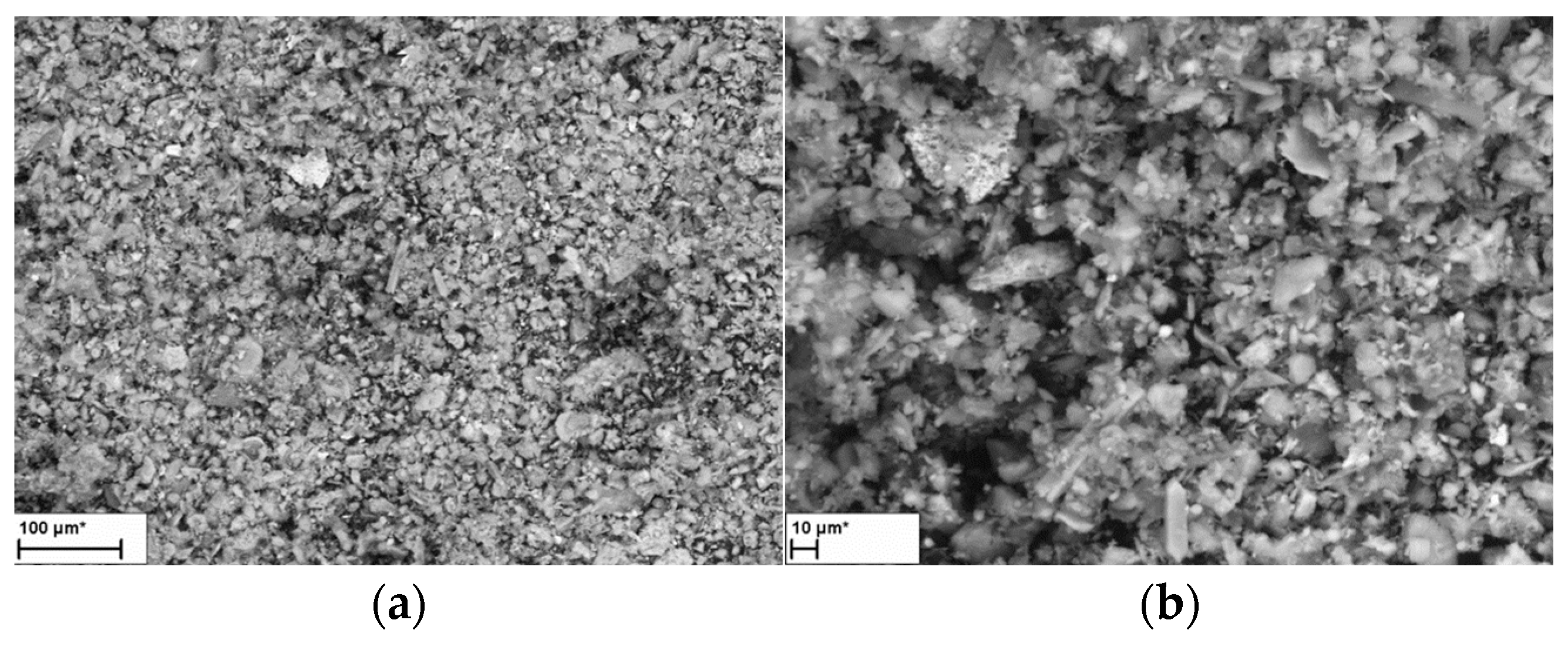
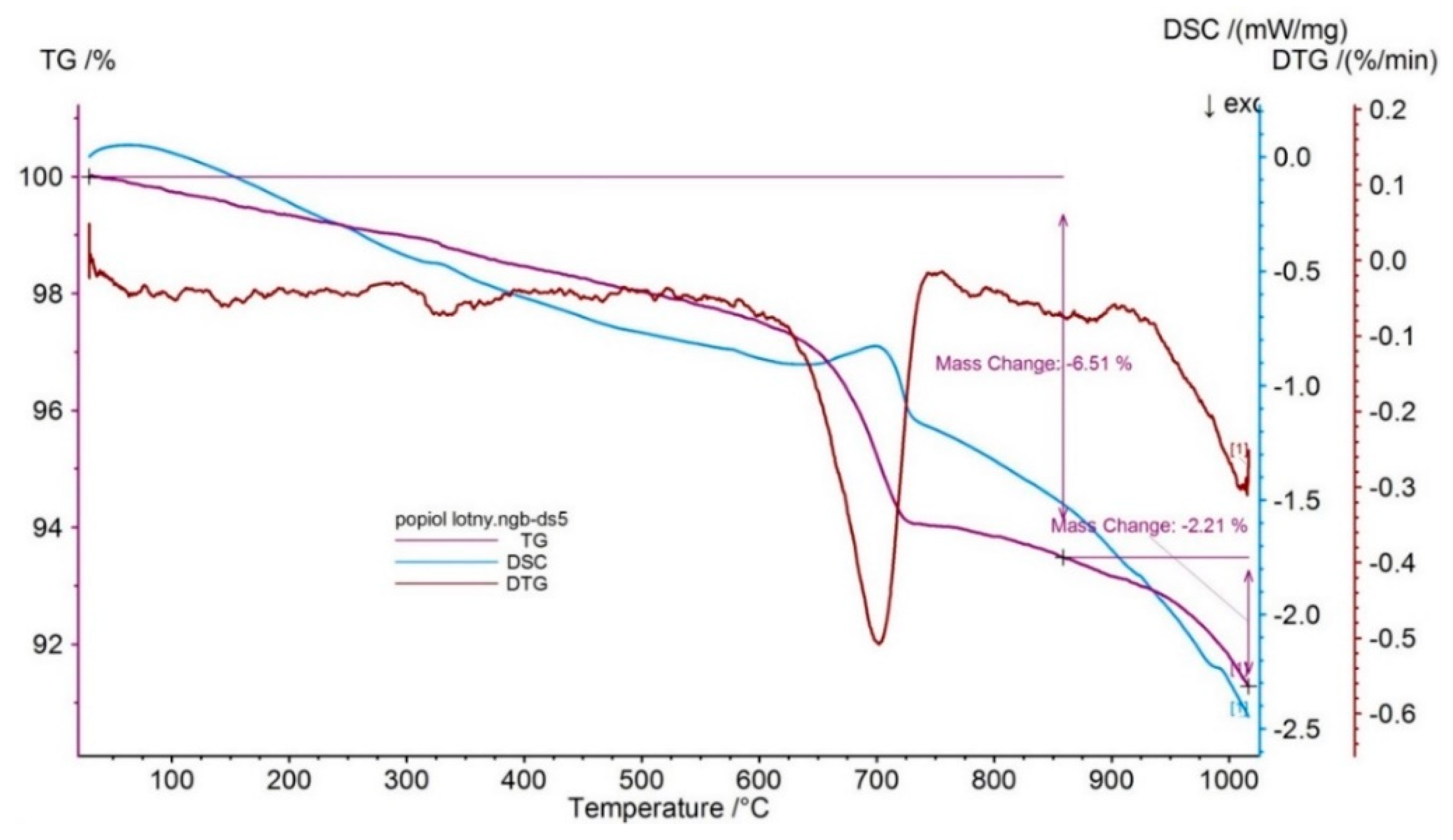
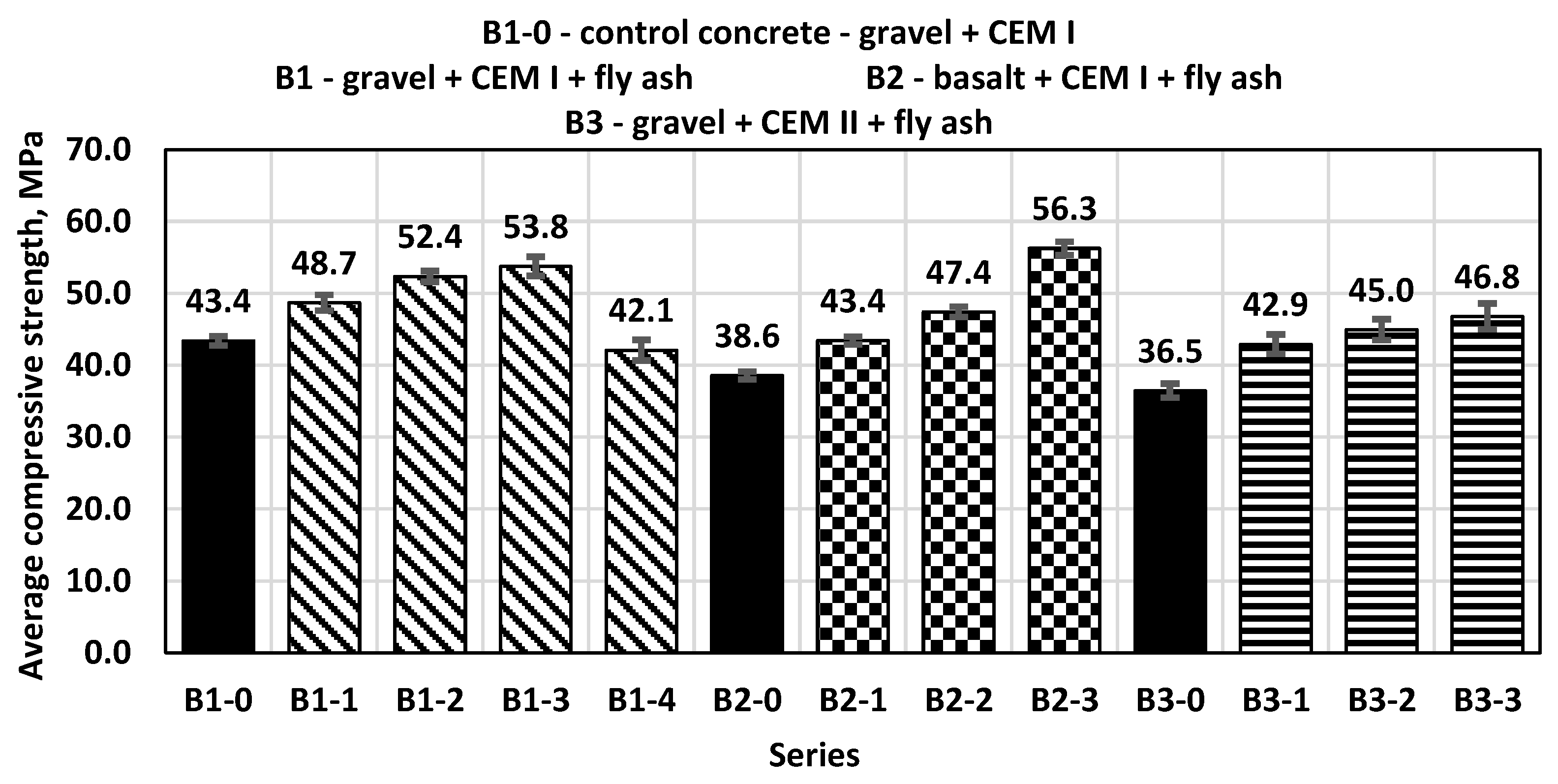
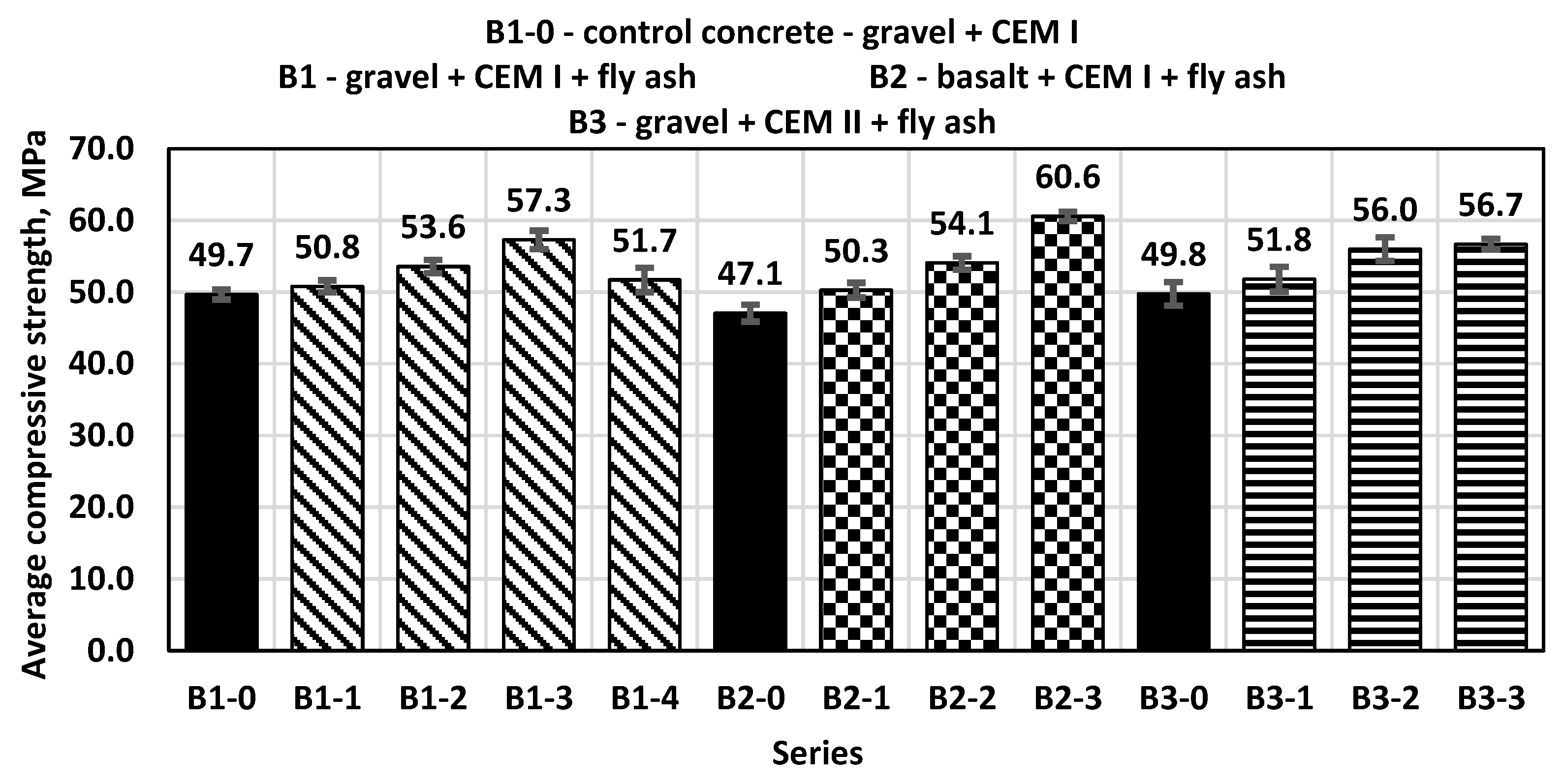
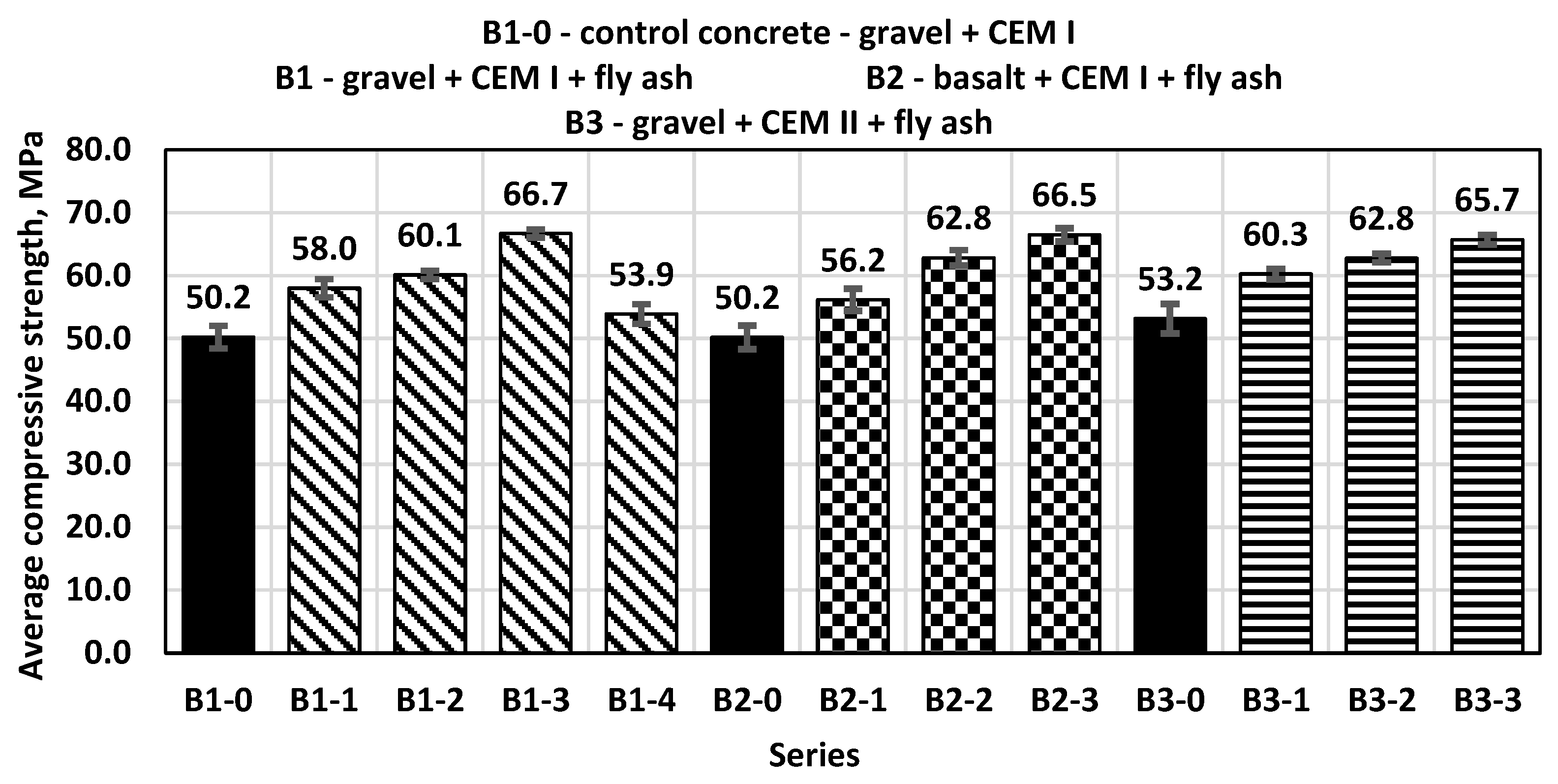
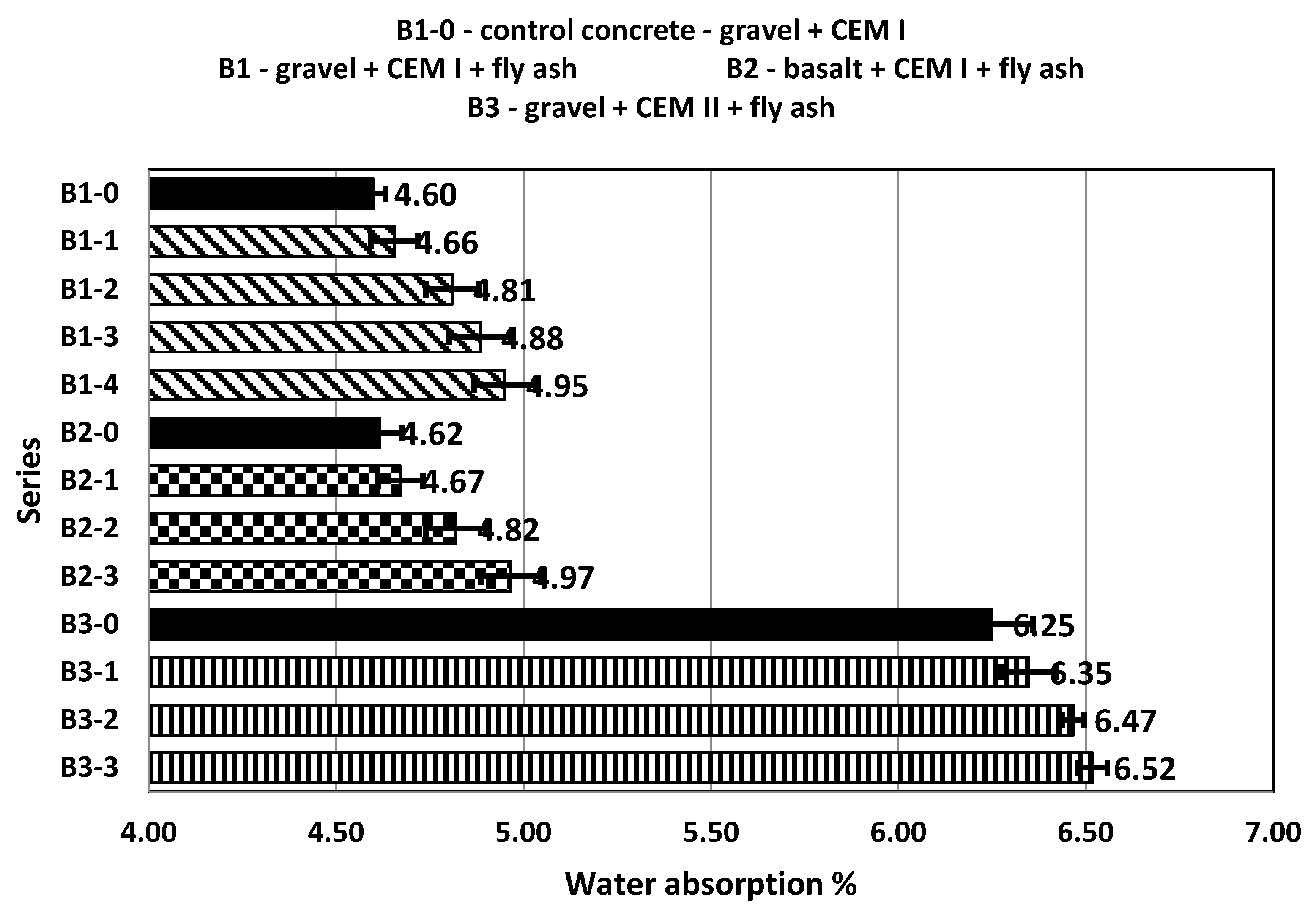
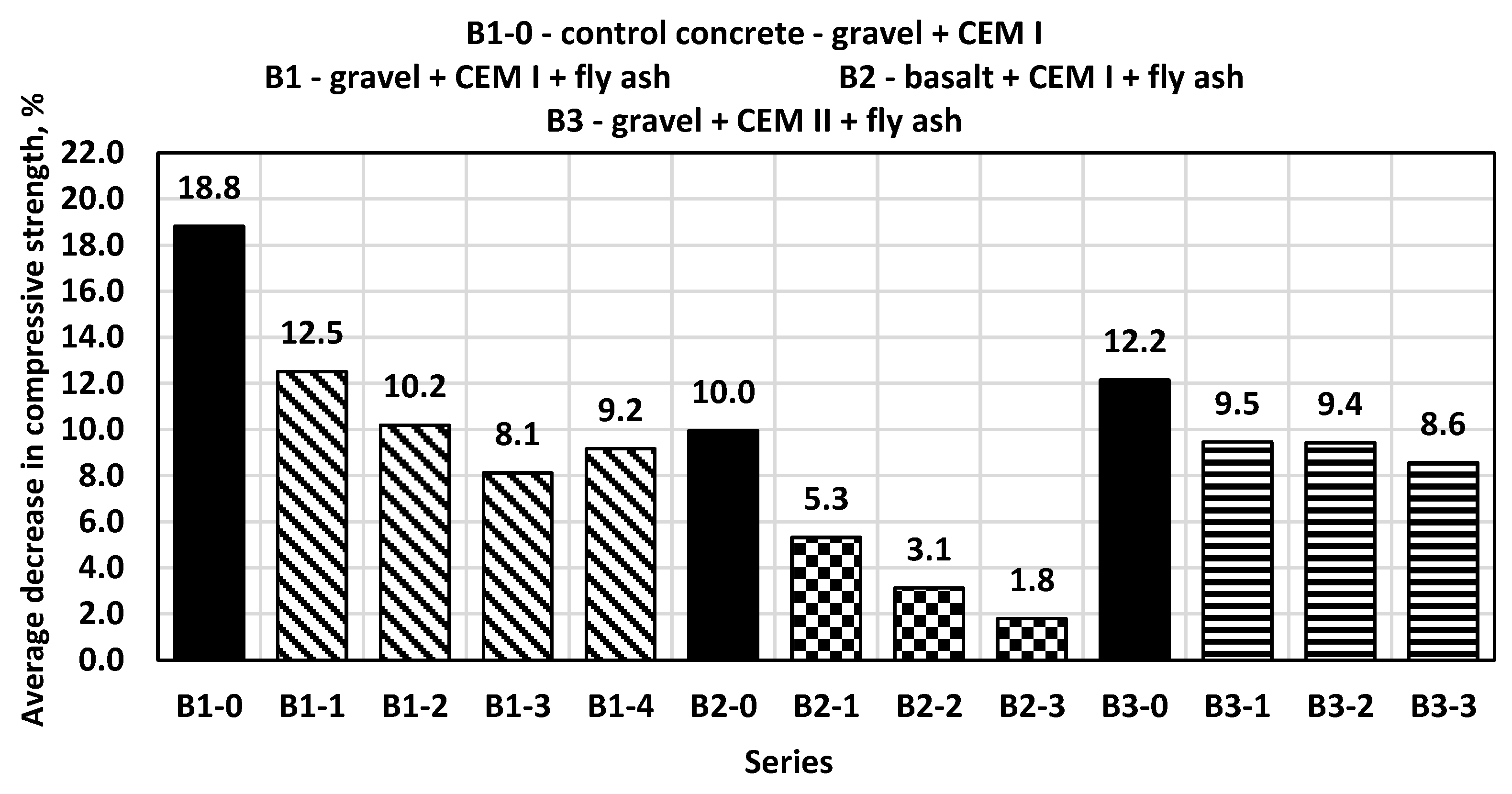
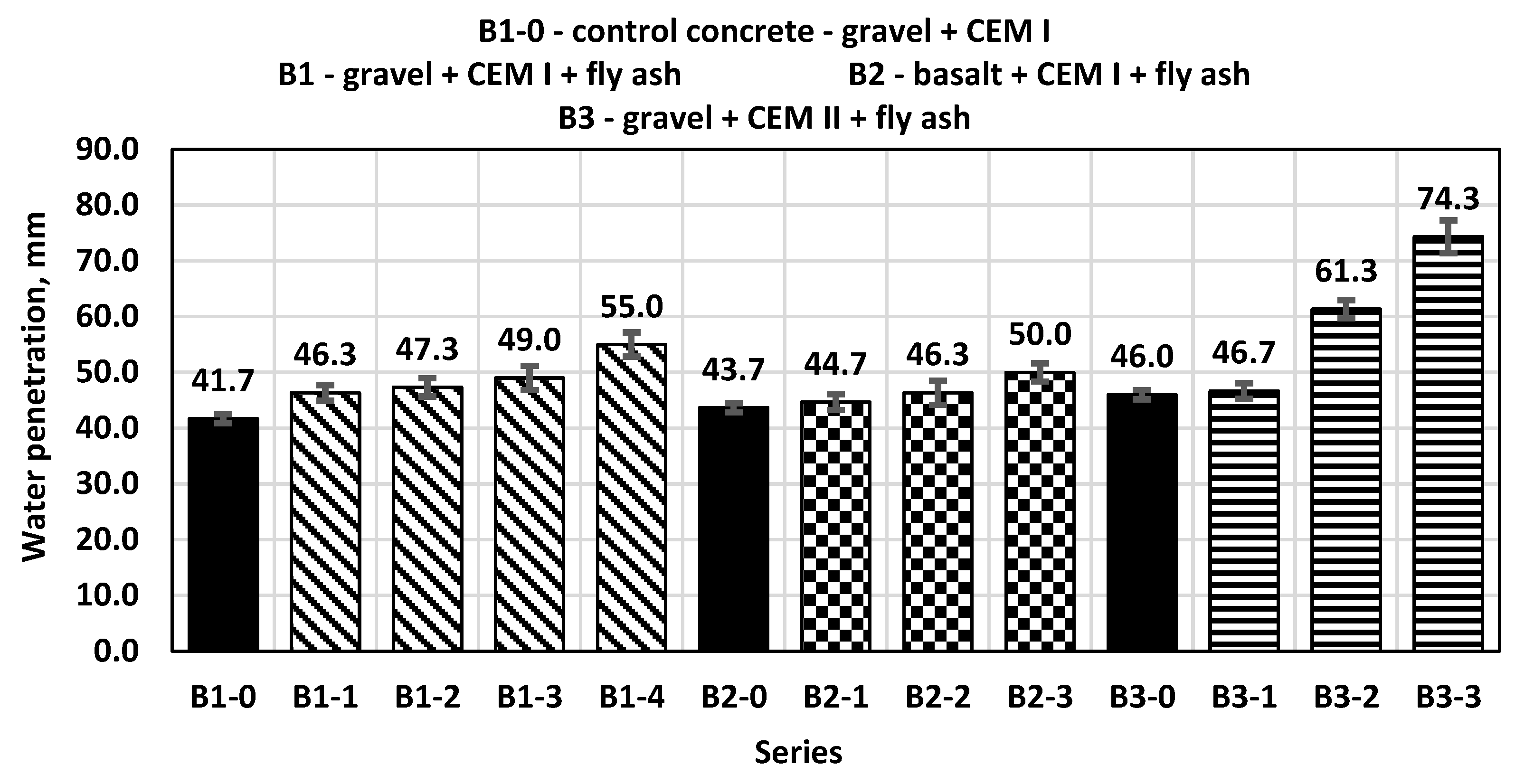
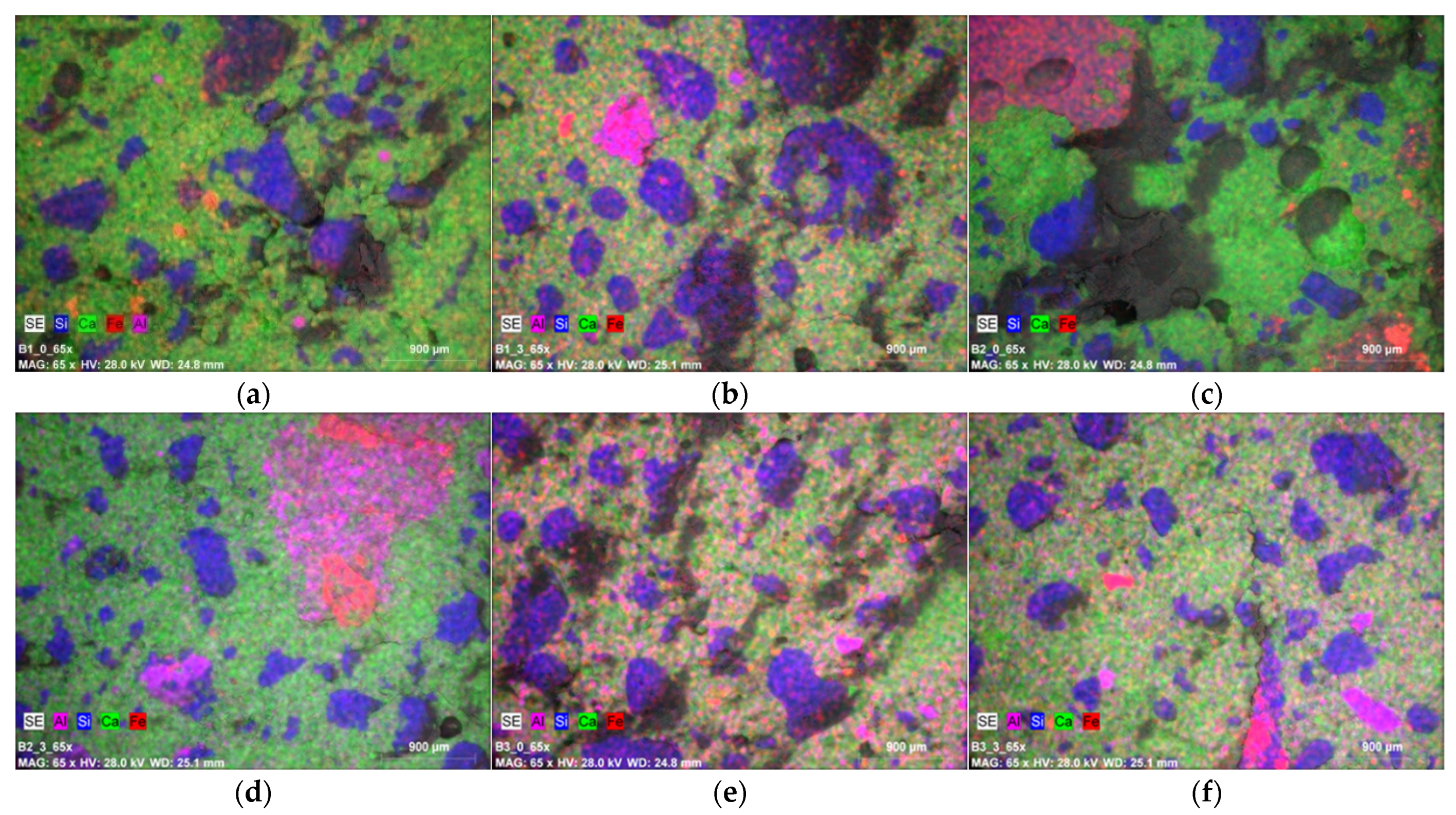
| Oxide/Element | Content % | Oxide/Element | Content % |
|---|---|---|---|
| SiO2 | 50.20 | Na2O | 0.44 |
| CaO | 11.82 | MnO | 0.28 |
| K2O | 7.99 | TiO2 | 0.30 |
| Al2O3 | 12.29 | SO3 | 4.91 |
| MgO | 3.34 | Cl | 1.63 |
| FexOy | 3.50 | Other | 3.30 |
| Concrete | B1-0 | B2-0 | B3-0 |
|---|---|---|---|
| Ingredient | Quantity | ||
| Cement CEM I, kg | 364.20 | 339.50 | - |
| Cement CEM II, kg | - | - | 364.20 |
| Water, dm3 | 191.40 | 200.00 | 191.40 |
| Aggregate—sand, kg | 648.20 | 757.50 | 648.20 |
| Aggregate G1; 2–8 mm, kg | 662.00 | - | 662.00 |
| Aggregate G2 8–16 mm, kg | 541.70 | - | 541.70 |
| Aggregate B1 2–8 mm, kg | - | 668.90 | - |
| Aggregate B2 8–16 mm, kg | - | 547.30 | - |
| Aggregate ∑, kg | 1851.90 | 1973.70 | 1851.90 |
| Plasticizer, dm3 | 1.82 | 2.72 | 1.82 |
| Concrete | B1-1 | B1-2 | B1-3 | B1-4 | B2-1 | B2-2 | B2-3 | B3-1 | B3-2 | B3-3 |
|---|---|---|---|---|---|---|---|---|---|---|
| Ingredient | Quantity | |||||||||
| Cement CEM I, kg | 364.20 | 364.20 | 364.20 | 364.20 | 339.47 | 339.47 | 339.47 | - | - | - |
| Cement CEM II, kg | - | - | - | - | - | - | - | 364.20 | 364.20 | 364.20 |
| Water, dm3 | 191.40 | 191.40 | 191.40 | 191.40 | 200.00 | 200.00 | 200.00 | 191.40 | 191.40 | 191.40 |
| Aggregate—sand, kg | 607.10 | 566.00 | 525.00 | 484.00 | 719.20 | 680.90 | 642.70 | 607.10 | 566.00 | 525.00 |
| Aggregate G1 2–8 mm, kg | 662.10 | 662.10 | 662.10 | 662.10 | - | - | - | 662.10 | 662.10 | 662.10 |
| Aggregate G2 8–16 mm, kg | 541.70 | 541.70 | 541.70 | 541.70 | - | - | - | 541.70 | 541.70 | 541.70 |
| Aggregate B1 2–8 mm, kg | - | - | - | - | 668.90 | 668.90 | 668.90 | - | - | - |
| Aggregate B2 8–16 mm, kg | - | - | - | - | 547.30 | 547.30 | 547.30 | - | - | - |
| Aggregate ∑, kg | 1810.9 | 1769.8 | 1728.8 | 1687.8 | 1935.4 | 1897.1 | 1858.8 | 1810.9 | 1769.8 | 1728.8 |
| Plasticizer, dm3 | 1.82 | 1.82 | 1.82 | 1.82 | 2.72 | 2.72 | 2.72 | 1.82 | 1.82 | 1.82 |
| Fly ash, kg | 36.40 | 72.80 | 109.20 | 145.60 | 33.95 | 67.89 | 101.84 | 36.40 | 72.80 | 109.20 |
| Series | Consistency Class B2-0 | Air Content, % | |
|---|---|---|---|
| Ingredient | mm | Class | |
| B1-0 | 145 | S3 | 3.4 |
| B1-1 | 95 | S2/S3 | 3.4 |
| B1-2 | 60 | S2 | 2.9 |
| B1-3 | 25 | S1 | 2.7 |
| B1-4 | 10 | S1 | 2.5 |
| B2-0 | 150 | S3 | 4.0 |
| B2-1 | 100 | S3 | 3.7 |
| B2-2 | 60 | S2 | 2.9 |
| B2-3 | 30 | S1 | 2.4 |
| B3-0 | 140 | S3 | 3.7 |
| B3-1 | 90 | S2 | 3.2 |
| B3-2 | 50 | S2 | 2.6 |
| B3-3 | 20 | S1 | 2.4 |
| Element | Sample | Limit Values | |||
|---|---|---|---|---|---|
| B1-0 | B1-3 | ||||
| A | s | A | s | ||
| mg/kg | mg/kg | mg/dm3 | |||
| Zn | <0.005 | <0.005 | 2 | ||
| Cu | 0.220 | 0.014 | 0.190 | 0.000 | 0.5 |
| Ni | 0.075 | 0.050 | 0.090 | 0.085 | 0.5 |
| Ba | 0.340 | 0.056 | 0.275 | 0.050 | 2 |
| Pb | 0.260 | 0.014 | 0.260 | 0.014 | 0.5 |
| Cr | 0.480 | 0.028 | 0.390 | 0.000 | 0.5 |
| Fe | 0.245 | 0.092 | 0.285 | 0.050 | 10 |
| K | 417.200 | 0.848 | 621.750 | 45.891 | 80 |
| Na | 184.900 | 29.699 | 186.550 | 8.273 | 800 |
Publisher’s Note: MDPI stays neutral with regard to jurisdictional claims in published maps and institutional affiliations. |
© 2021 by the authors. Licensee MDPI, Basel, Switzerland. This article is an open access article distributed under the terms and conditions of the Creative Commons Attribution (CC BY) license (https://creativecommons.org/licenses/by/4.0/).
Share and Cite
Jura, J.; Ulewicz, M. Assessment of the Possibility of Using Fly Ash from Biomass Combustion for Concrete. Materials 2021, 14, 6708. https://doi.org/10.3390/ma14216708
Jura J, Ulewicz M. Assessment of the Possibility of Using Fly Ash from Biomass Combustion for Concrete. Materials. 2021; 14(21):6708. https://doi.org/10.3390/ma14216708
Chicago/Turabian StyleJura, Jakub, and Malgorzata Ulewicz. 2021. "Assessment of the Possibility of Using Fly Ash from Biomass Combustion for Concrete" Materials 14, no. 21: 6708. https://doi.org/10.3390/ma14216708
APA StyleJura, J., & Ulewicz, M. (2021). Assessment of the Possibility of Using Fly Ash from Biomass Combustion for Concrete. Materials, 14(21), 6708. https://doi.org/10.3390/ma14216708







